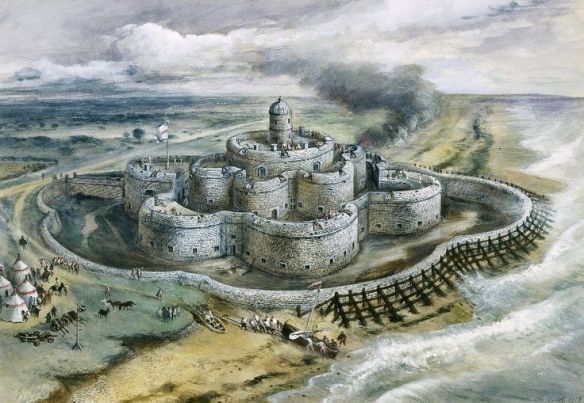27th December 1539, Anne of Cleves landed at Deal in Kent. Anne was to be Henry VIII’s fourth wife and their marriage was agreed by a treaty in September 1539. Built by the order of King Henry VIII it is one of the finest Tudor artillery castles in England, and among the earliest and most elaborate of a chain of coastal forts, which also includes Calshot, Camber, Walmer and Pendennis Castles.
Two guns of 16th century style similar to those mounted on Mary Rose. In front is a bronze cast culverin and behind is a wrought iron cannon, a so-called port piece. I believe these guns are modern historical reconstructions made using similar techniques and materials as the originals for research purposes and test firing.
artillery and military architecture, they played a more prominent role in the reshaping of combat at sea. Under Henry VIII, naval warships were systematically provided with heavy cast guns that could fire broadside through gun ports running along one or more decks of the ship. The distinctive naval gun carriage also seems to have been developed in England during Henry VIII’s reign. Rather than the two large wheels and trailing tailpiece of a siege gun, the new sea carriage consisted of a wooden bed provided with four small solid wheels. This compact design enabled the guns to be quickly maneuvered and reloaded and was vital to the high rate of fire for which English sea gunners were noted. By the time of the Spanish Armada in 1588, the English navy’s tactics had been adapted to artillery warfare: they avoided close engagement and boarding, seeking to inflict damage from a distance.
There was also English innovation in the manufacture of cast guns. Although bronze remained the preferred material, Henry VIII’s encouragement of arms manufacture led to the development of iron as an alternative. Cast-iron guns, produced principally in the Weald of Kent and Sussex, were substantially cheaper than their bronze counterparts. However, their cost advantage was partly offset by their quality. They were more prone to casting flaws and, to secure safe handling, were often made heavier and thicker than equivalent bronze pieces. The weapons themselves were manufactured in many sizes and shapes. Guns were identified and classified by name; the cannon and demicannon represented the heavy end of a scale that passed through culverins, sakers, and minions, and included smaller and lighter pieces such as the falcon and the falconet. Each piece would bear a family resemblance in weight and proportions to others in the same category, but standardization was impossible: after casting, the mold for each gun had to be broken open in order to remove the piece inside it.
The principal ammunition fired by these guns was iron shot. Stone balls had been standard in the fifteenth century and were still used, but stone-throwing guns (perriers) became less common through the sixteenth century. A range of other ammunition such as chain shot was favored for antipersonnel use and for disabling the rigging of enemy ships.
Most heavy guns were fired at point-blank range, with the gun set up to shoot horizontally. However, it was early recognized that greater range could be achieved by elevating the gun above the line of the horizon. Niccolo Tartaglia’s Nova scientia (1537) provided the first published account of the relation between elevation and range of shot. This Italian text combined natural philosophy and mathematics and became the major point of reference for later ballistic discussions of the sixteenth century. Elizabethan authors such as William Bourne (1578) and Cyprian Lucar (1588) drew on and adapted Tartaglia’s work, describing the path of the shot as proceeding initially in a straight line, followed by a curved section, and then a final vertical descent to the ground.
While artillery texts provided recipes for gunpowder and discussed the necessary routines for priming and firing a gun, ballistics was recognized as the most mathematically challenging aspect of the art. While not achieving the success of Galileo’s work on the parabolic character of the path of an ideal projectile (published in 1638), several English mathematicians conducted independent research on ballistic problems. The mathematical author Leonard Digges carried out a program of trials as early as the 1540s and rejected many of Tartaglia’s conclusions. Although his work remained unpublished, his son, Thomas Digges, printed a series of questions on artillery in 1579 that went beyond Tartaglia’s account of ballistics. The most sophisticated Elizabethan studies of ballistics were conducted by Thomas Digges’s younger contemporary, Thomas Hariot. Hariot’s account of artillery trajectories sought to incorporate air resistance into the geometry of the projectile’s path. However, his work remained in manuscript and had no impact on the mainstream of military literature, which continued to follow the theories of Tartaglia.
BIBLIOGRAPHY Hall, A. R. Ballistics in the Seventeenth Century. 1952. Kennard, A. N. Gunfounding and Gunfounders. 1986. Martin, Colin, and Geoffrey Parker. The Spanish Armada. 1988. Webb, Henry J. Elizabethan Military Science: The Books and the Practice. 1965
